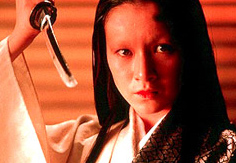

Hidetora sinks into madness as his plan to divide his empire among his three sons collapses into war, and his heirs turn on one another — none more chillingly than his deceptively reserved daughter-in-law, Lady Kaede (Mieko Harada). Her transformation from hand-maiden to hell-hound is a good example of how the quality of this movie transcends the cultural gap between filmmaker and audience.(from Margaret McGurk's review)When we first see her move, the swish of her heavy silk robes sounds a little intrusive. Later, after she has revealed herself, we hear her coming and we recognize her by that slight noise, which becomes as ominous as the sound of sharpening knives.
University of Michigan synopsis
Cornell Japanese Cinema Studies
Director Akira Kurosawa perceives Ran as his best film, an appraisal that many Japanese and Western film critics believe entirely justified. Running at over two hours and fourty minutes, its epic sweep, haunting score, and visual majesty rank among the greatest of all film accomplishments. The clever incorporation of traditional Japanese theatrical forms and motifs, a hallmark of many past Kurosawa films, find their fullest expression in Ran. Possibly most important for the success of Kurosawa's film is its philosophical and existential dimensions. Through both its scenic beauty and dramatic import, Ran attempts to convey an intensely felt humanist message.Roger Ebert on Ran and a second take